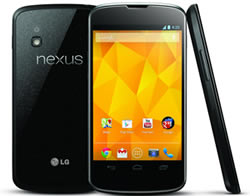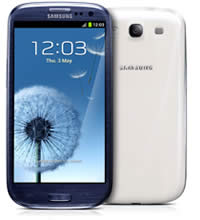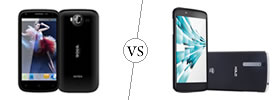Difference between Nexus 4 and Samsung Galaxy S3
Key Difference: Samsung Galaxy S3 is a slate-format multi-touch smartphone. It is a successor of Galaxy S2 and Galaxy S but abandons the rectangular design of the predecessors and opts for more rounded corners making it resemble the Galaxy Nexus. It is offered with Android v4.0.4 (Ice Cream Sandwich) and can be upgraded to 4.1.2 (Jelly Bean). The Nexus 4 is Google's fourth Nexus-branded Android smartphone. It was produced in collaboration with LG Electronics. The phone runs on the Android 4.2 (Jelly Bean) operating system, which was launched with the phone.
Technology is a dynamic sector that often changes when new technology replaces the old outdated technology. This is most commonly seen in smartphones and tablets. People are constantly changing their cell phones to keep up with new technologies and the companies release new phones to cater to the demand of the peoples. Smartphones have become a way of life for many people, allowing them to do anything and everything on the go. This includes typing up a document, chatting with friends, video conferencing, writing up reports, checking e-mails, etc.
One of the most popular operating systems for smartphones and tablets is Android. Android is a Linux-based operating system owned and operated by the Open Handset Alliance, a consortium of 84 leading firms, which includes mobile handset makers, application developers, some mobile carriers and chip makers. The consortium is lead in part by Google, as well as HTC, Sony, Dell, Intel, Motorola, Qualcomm, Texas Instruments, Samsung Electronics, LG Electronics, T-Mobile, Sprint Nextel, Nvidia, and Wind River Systems.
A number of these companies’ smartphones and tablets run on Android. Android is an open source software, which means that the code is freely available for modification and distribution by device manufacturers, wireless carriers and enthusiast developers. Among the number of various companies, Google has also launched its own line of smartphones based on Android, called the Google Nexus. Each device in the Nexus line is produced via collaboration between Google and a leading original equipment manufacturer (OEM) partner.
 The Nexus devices in general have an advantage over other devices in that the Android in the Nexus devices is pure. I.e. the Android does not have any manufacturer or wireless carrier modifications to it, such as a custom graphical user interface. The Android also has an unlockable bootloader to allow further development and end-user modification, all of which is usually blocked on other Android smartphones.
The Nexus devices in general have an advantage over other devices in that the Android in the Nexus devices is pure. I.e. the Android does not have any manufacturer or wireless carrier modifications to it, such as a custom graphical user interface. The Android also has an unlockable bootloader to allow further development and end-user modification, all of which is usually blocked on other Android smartphones.
The Nexus 4 is Google's fourth Nexus-branded Android smartphone. It was produced in collaboration with LG Electronics. The phone features a 1.5 GHz quad-core Snapdragon S4 Pro processor, 2 GB of RAM, 8 or 16 GB of internal storage, front facing 1.3 megapixel camera and an 8 megapixel rear camera and a micro-SIM card tray. The phone runs on the Android 4.2 (Jelly Bean) operating system, which was launched with the phone. The phone also features a new camera technology, called the Photo Sphere. This allows one to take 360 deg Panorama shots.

The Galaxy S3 is a slate-format multi-touch smartphone. It is a successor of Galaxy S2 and Galaxy S but abandons the rectangular design of the predecessors and opts for more rounded corners making it resemble the Galaxy Nexus. The S3 sports a 4.8 HD Super AMOLED screen with corning gorilla glass 2. It is offered with Android v4.0.4 (Ice Cream Sandwich) and can be upgraded to 4.1.2 (Jelly Bean). The Galaxy S III has a polycarbonate plastic chassis and is available in a variety of different colors. The S3 supports a 1.4 GHz Cortex-A9 Quad-core processor, Mali-400MP GPU and 1 GB RAM. The S3 is available with 16 or 32 GB internal storage capacity, which can be expanded up to an additional 64 GB. The phone boasts an 8 megapixel Auto Focus camera with flash, zero shutter lag and BSI. It also supports a 1.9 megapixel secondary camera that is capable of recording HD videos @30fps. When the phone was initially launched in May, the phone was considered to have been backed with innovative features and the TouchWiz "Nature UX" GUI was considered to be advanced. The GUI also included the “Water Lux” effect which can produce water ripples on contact. The phone also offered S Voice in response to Apple’s Siri, which enabled users to verbally control 20 functions on the phone. It was effectively considered as a iPhone killer. It also received additional publicity because of the ongoing patent infringement lawsuits against Apple.
Nexus 4 has been constantly sold out since its launch in November. It is also stated to be the cheapest smartphone that offers features similar to the expensive ones. Google has also provided innovative features such as new photosphere camera. According to experts the only reason that Nexus 4 could not compete properly with the Galaxy S3 or the iPhone 5 was due to inventory shortage and the long wait lines.
The information for the detailed table about the two phones has been taken from the Google Nexus website, Samsung website and GSMArena.com.
|
|
Samsung Galaxy S3 |
Nexus 4 |
|
Launch Date |
May 2012 |
November 2012 |
|
Company |
Samsung Electronics |
Google; designed in collaboration with and manufactured by LG Electronics. |
|
Size |
136.6 x 70.6 x 8.6 mm |
133.9 x 68.7 x 9.1 mm (5.27 x 2.70 x 0.36 in) |
|
Display |
4.8 inch HD Super AMOLED |
True HD IPS Plus capacitive touchscreen, 16M colors |
|
Screen |
1280x720 pixels |
768 x 1280 pixels, 4.7 inches (~318 ppi pixel density) |
|
Protection |
Corning Gorilla Glass 2 |
Corning Gorilla Glass 2 |
|
Weight |
133 g |
139g (4.90 oz) |
|
2G Network |
2.5G (GSM/ GPRS/ EDGE): 850/900/1800/1900 MHz |
GSM 850 / 900 / 1800 / 1900 |
|
3G Network |
(HSPA+ 21Mbps): 850/900/1900/2100 MHz |
HSDPA 850 / 900 / 1700 / 1900 / 2100 |
|
4G Network |
Depends on market availability. |
No |
|
GUI |
TouchWiz "Nature UX" |
Pure Android |
|
CPU speed |
Quad-core 1.4 GHz Cortex-A9 |
Quad-core 1.5 GHz Krait |
|
GPU |
Mali-400MP |
Adreno 320 |
|
OS |
Android OS, v4.0.4 (Ice Cream Sandwich), upgradeable to 4.1.2 (Jelly Bean) |
Android OS, v4.2 (Jelly Bean), upgradable to v4.2.2 (Jelly Bean) |
|
Chipset |
Exynos 4412 Quad |
Qualcomm APQ8064 Snapdragon |
|
RAM |
1 GB |
2 GB RAM |
|
SIM Size |
microSIM |
microSIM |
|
Internal Memory |
16/32/64 GB (The 64GB model has been discontinued) |
8/16 GB storage |
|
Expandable Memory |
Yes, microSD up to 64 GB |
None |
|
Sensors |
Accelerometer, RGB light, Digital compass, Proximity, Gyro, Barometer |
Accelerometer, gyro, proximity, compass, barometer |
|
Connectivity |
WiFi a/b/g/n, WiFi HT40, GPS/GLONASS, NFC, Bluetooth® 4.0(LE), microUSB v2.0, USB On-the-go, Wireless charging. |
WiFi 802.11 a/b/g/n, Bluetooth, NFC (Android Beam), Unlocked GSM/UMTS/HSPA+, GSM/EDGE/GPRS, 3G, HSPA+ 42, Wireless charging, SlimPort (TM) |
|
Data |
GPRS, EDGE, WLAN, Bluetooth, NFC and USB. |
WiFi, NFC, GPRS, EDGE, USB |
|
Speed |
HSDPA, 21 Mbps; HSUPA, 5.76 Mbps |
DC-HSDPA, 42 Mbps; HSDPA, 21 Mbps; HSUPA, 5.76 Mbps |
|
WLAN |
Wi-Fi 802.11 a/b/g/n, dual-band, DLNA, Wi-Fi Direct, Wi-Fi hotspot |
Wi-Fi 802.11 a/b/g/n, dual-band, DLNA, Wi-Fi hotspot |
|
Bluetooth |
Bluetooth 4.0 with A2DP, EDR. |
Bluetooth v4.0 with A2DP |
|
USB |
micro-USB 2.0; USB On-the-go. |
microUSB (SlimPort) v2.0 |
|
Primary Camera |
8 megapixel Auto Focus camera with Flash & Zero Shutter Lag, BSI. |
8 MP, 3264 x 2448 pixels, autofocus, LED flash, check quality |
|
Secondary Camera |
1.9 Mega pixel camera, HD recording @30fps with Zero Shutter Lag, BSI |
1.3 MP |
|
Video |
1080p@30fps, zero shutter lag. |
1080p@30fps |
|
Camera Features |
Simultaneous HD video and image recording, geo-tagging, touch focus, face and smile detection, image stabilization. Burst shot & Best photo, Recording snapshot, HDR. |
Touch focus, geo-tagging, face detection, photo sphere |
|
Sound Enhancement |
Active noise cancellation with dedicated mic. |
SNS integration Active noise cancellation with dedicated mic |
|
Audio supported formats |
Audio Codec: MP3, AMR-NB/WB, AAC/AAC+/eAAC+, WMA, OGG, FLAC, AC-3, apt-X. |
MP3/WAV/eAAC+/AC3 player |
|
Video supported formats |
Video Codec: MPEG4, H.264, H.263, DivX, DivX3.11, VC-1, VP8, WMV7/8, Sorenson Spark Recording & Playback: Full HD (1080p). |
MP4/H.264/H.263 player |
|
Battery Capacity |
2100 mAh battery |
2100 mAh battery |
|
Available Colors |
Pebble blue, Marble white, Amber brown, Garnet red, Sapphire black, Titanium grey, La Fleur |
Black |
|
Messaging |
SMS(threaded view), MMS, Email, Push Mail, IM, RSS |
SMS(threaded view), MMS, Email, Push Mail, IM, RSS |
|
Browser |
HTML, Adobe Flash |
HTML5 |
|
Radio |
Stereo FM radio with RDS |
No |
|
GPS |
A-GPS support and GLONASS |
A-GPS support and GLONASS |
|
Java |
Java MIDP emulator |
Java MIDP emulator |
|
Additional Features |
S-Voice natural language commands and dictation, Smart Stay eye tracking, Dropbox (50 GB storage), TV-out (via MHL A/V link), SNS integration, MP4/DivX/XviD/WMV/H.264/H.263 player, MP3/WAV/eAAC+/AC3/FLAC player, Organizer, Image/video editor, Document viewer (Word, Excel, PowerPoint, PDF), Google Search, Maps, Gmail, YouTube, Calendar, Google Talk, Picasa, Voice memo/dial/commands, Predictive text input (Swype) |
Android 4.2 (Jelly Bean), Accelerometer, GPS, Gyroscope, Barometer, Microphone, Ambient light, Compass, Organizer, Image/video editor, Document editor, Google Search, Maps, Gmail, YouTube, Calendar, Google Talk, Picasa, Voice memo/dial/commands, Predictive text input |
Image Courtesy: blogs.computerworld.com, samsung.com









Add new comment